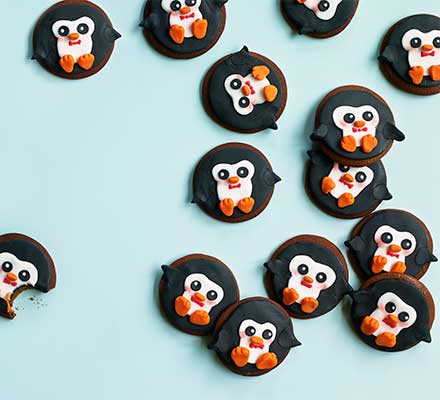Christmas gingerbread penguins
Make a batch of cute Christmas gingerbread penguins and you'll be everyone’s favourite person. Give them as gifts, or serve them at a festive afternoon tea
-
Prep:2 hrs
Cook:35 mins
Plus at least 2hrs chilling and overnight setting - Easy
Nutrition per serving
-
kcal 186
-
fat 3g
-
saturates 2g
-
carbs 38g
-
sugars 31g
-
fibre 1g
-
protein 1g
-
salt 0.2g
Ingredients
- 75g golden syrup
- 30ml orange juice
- 100g molasses sugar
- 1 tbsp ground ginger
- ½ tbsp ground cinnamon
- 1 tsp vanilla bean paste
- 100g butter, diced
- 1 tsp bicarbonate of soda
- 240g plain flour
- apricot jam, for sticking
- 500-600g black fondant icing or sugar paste
- icing sugar, for rolling
- 300g white fondant icing or sugar paste
- 20g orange or yellow icing or sugar paste (or colour some white yourself)
- red colouring and dust (optional)
Tip
Check that your biscuits are readyTo test for doneness, press the biscuits with your finger – the gingerbread should spring right back.
Method
Mix the golden syrup, orange juice, sugar, spices and vanilla in a pan. Heat, stirring regularly, over a medium-low heat until all the sugar is dissolved and everything is combined – don’t let the mixture boil. Add the butter, and stir until melted and incorporated into the hot sugar mix.
Add the bicarb and whisk until fluffy and pale. Pour into a mixing bowl. Allow to cool slightly, then add the flour and beat on slow, or mix with a wooden spoon, until the mixture comes together and resembles an oily dough – it should be gloopy, pliable and runny, but will harden as it cools and sets.
Using a spatula, tip the dough onto two large pieces of cling film laid out in a cross, one on top of the other. Wrap up to seal, then chill in the fridge for at least two hours or overnight. The dough can be made ahead to this stage and frozen for up to a month. Defrost in the fridge overnight, then leave at room temperature for 1 hr before kneading until pliable.
Heat oven to 180/160C fan/gas 4 and line a couple of baking trays with baking parchment. Roll out the dough on a lightly-floured surface to a thickness of around ¾ cm. Using a round cutter with a diameter of 6-7cm, stamp out little rounds and transfer to the trays, leaving a 1cm gap between each one. Bake for 12-15 mins until darkened and firm (see tip, right). Transfer to a wire rack and leave to cool.
Warm a tbsp of apricot jam with a little water until just boiling. Brush each cookie with the jam to aid sticking. Roll out the black fondant icing with a little icing sugar to a thickness of 2mm. Use the same round cutter as before to punch out little black circles, then stick them to the cookies. Use the excess icing to make two little wings for each cookie (keep some back to make the eyes). Roll the icing into 28 small balls, then halve each. Press a half onto the sides of each biscuit to make the wings
For the chest and face detail, roll out the white icing to a similar thickness as the black. Stamp out a smaller round shape, then use your fingers to stretch out the top to create the face shape. Mould the tummy by pinching the icing in a little where the face joins the tummy. Stick the moulded white icing onto the black icing with a little water.
For the beak, mould tiny pieces of the orange icing into triangles. To make the feet, shape the icing into tear drop shapes (two for each biscuit), press a little to flatten, then make two indentations to create the flipper effect. Stick to the biscuits with a dab of water, the beak towards the bottom of the face, the feet just below the white icing.
For the face, make two small circles for each biscuit – either using a tiny polka dot cutter or making small flat discs – then stick to the face. Add a small ball of white icing to each black circle to create a sparkle on each eye. Add a bow tie, if you like, with a small brush dipped in food colouring, and rosy cheeks using a little red dust colour with a paintbrush under each eye. Leave to set overnight, then wrap as gifts or serve.





















